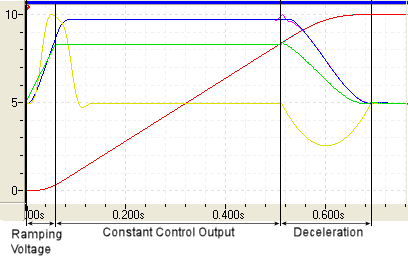
|
Supported Axes: |
Position Control Axes |
|
Supported Control Modes: |
See the Commands Overview topic for basic command information and how to issue commands from PLCs, HMIs, etc.
Command Parameters
|
# |
Parameter Description |
Range |
|
1 |
Requested Position (position-units) |
any |
|
2 |
Requested Output (RMC75/150: V) (RMC200: %) |
RMC75/150: 0-10 V RMC200: 0-100 % |
|
3 |
Output Ramp Rate (RMC75/150: V/sec) (RMC200: %/sec) |
>0 |
|
4 |
Deceleration Rate (position-units/s2) |
>0 |
|
5 |
Direction
* These options are intended for use with rotary axes. However, all options are available on linear axes, but have no effect. For more details, see the Using Rotary Motion topic. |
a valid integer as described |
Description
This command moves to the Requested Position with a combination of open loop and closed loop control. The first part of the move is made in open-loop control, then the axis switches to closed-loop control for the deceleration to the Requested Position.
This command is called "quick" because it makes it possible to give the maximum Control Output to move the system at its maximum speed. In closed loop control, reaching the maximum Control Output would cause an error.
When this command is issued, the axis ramps the Control Output in open loop from the current value to the RequestedOutput at the specified Output Ramp Rate. The Control Output stays at that value until the axis must begin decelerating in order to reach the Requested Position at the specified Deceleration Rate. Once the axis starts decelerating (which can happen while the Control Output is being ramped or while it is constant), the axis switches to closed loop, setting the Target Position and Velocity to the Actual Position and Velocity. The axis will hold the final position in closed loop control.
It is important that the closed-loop motion is tuned properly before using the Quick Move command! A Velocity Feed Forward that is incorrect may result in a discontinuity in the Control Output, causing the system to jerk.
The plot below shows a typical Quick Move. Notice how the Control Output ramps up linear, is flat, and when the axis switches to closed-loop control, the Control Output ramps down in a curved fashion.

Special Notes
Switching to closed-loop while Control Output is still ramping
The Quick Move command works best if the Control Output reaches its constant value before the axis switches to closed-loop control. If the switch from open-loop to closed-loop control occurs while the Control Output is ramping, the Actual Position may lag behind the Target Position momentarily. This is because the Target Acceleration is set to zero at this point, while the Actual Acceleration was likely non-zero. This discontinuity may cause some control issues.
Actual Velocity and/or Actual Acceleration filtering may be required
During the course of the Quick Move, the RMC calculates when it has to start decelerating in order to reach the requested position. At that point, it switches into closed loop control. When switching to closed loop control, the RMC uses the actual velocity and actual acceleration to determine the target profile to the requested position. If the velocity and/or acceleration feedback is noisy, the RMC may enter closed loop control to late, causing the Target Position to overshoot the requested position, or the RMC may calculate a very strange route to the requested position. If this occurs, you may need to filter the velocity.
For the RMC75 and RMC150, set the Actual Velocity Filter. For the RMC200, set the Velocity Display Filter.
Status Bits
In Position Bit
When the Target Position reaches the Requested Position and the Actual Position is within the In Position Tolerance window, the In Position Status bit will be set. This bit indicates that the move is complete and the axis is at position.
Target Generator State Bits
The Target Generator bits in the Status Bits register indicate which portion of the move the axis is currently in. These bits are useful when programming complex motion sequences.
Target Generator Done bit
This bit indicates the move is complete, which occurs when the Target Position has reached the Requested Position. Notice that this bit does not indicate whether the Actual Position has reached the Command Position.
Target Generator State A and B bits
|
B |
A |
Description |
|
0 |
0 |
The target generator is complete |
|
0 |
1 |
Ramping Control Output in Open Loop |
|
1 |
0 |
Constant Control Output at Requested Output |
|
1 |
1 |
Decelerating in Closed Loop |
See Also
Quick Move Relative (16) | List of Commands | Commands Overview
Copyright © 2025 Delta Computer Systems, Inc. dba Delta Motion